Opportunity Solution Trees: Visualize Your Discovery to Stay Aligned and Drive Outcomes
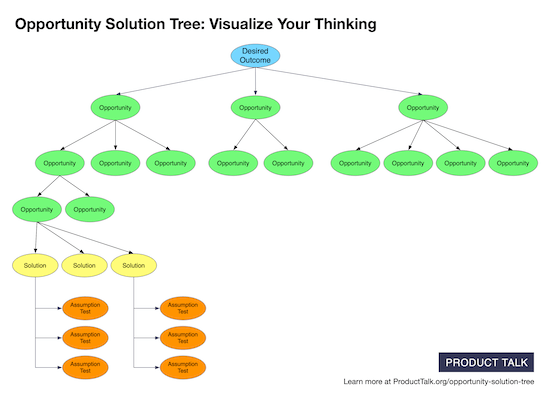
Opportunity solution trees help product teams chart the best path to their desired outcome. They keep the team aligned as they manage the messy cycles of continuous discovery.
In this article, we’ll cover what an opportunity solution tree is, the benefits of using one, how to create one, and so much more.
Let’s dive right in. You can read this article from beginning to end or you can use the links below to jump to any question.
- What is an opportunity solution tree?
- What are the benefits of using an opportunity solution tree?
- Who should create an opportunity solution tree?
- Are there any prerequisites to using an opportunity solution tree?
- How do you create an opportunity solution tree?
- Understanding the Outcome at the Top of an Opportunity Solution Tree
- Understanding the Opportunity Space
- What is an opportunity?
- What’s the difference between an opportunity and a solution?
- How do you test to make sure your opportunity is not a solution in disguise?
- Why is it called an opportunity and not a problem?
- How do you find opportunities?
- Why can’t you just generate opportunities from what you know about your customers?
- Can you create opportunities from sales conversations, support tickets, feature requests, or behavioral analytics?
- Mapping the Opportunity Space
- Choosing a Target Opportunity
- Understanding Solutions
- Tools & Templates
- Managing Scope & Iterations
- When should you start a new opportunity solution tree?
- How often should you update your opportunity solution tree?
- What’s the best way to introduce the opportunity solution tree to your team?
- What’s the best way to run an opportunity solution tree workshop?
- Can you create one opportunity solution tree for the entire company?
- Managing Expectations with Stakeholders
- Examples of Opportunity Solution Trees
- What other questions do you have about opportunity solution trees?
What is an opportunity solution tree?

Opportunity solution trees are a simple way of visually representing the paths you might take to reach a desired outcome.
The root of the tree is your desired outcome—the business need that reflects how your team can create business value.
Next is the opportunity space. These are the customer needs, pain points, and desires that, if addressed, will drive your desired outcome.
Below the opportunity space is the solution space. This is where we’ll visually depict the solutions we are exploring.
Below the solution space are assumption tests. This is how we’ll evaluate which solutions will help us best create customer value in a way that drives business value.
Learn about the origin of opportunity solution trees.
What are the benefits of using an opportunity solution tree?
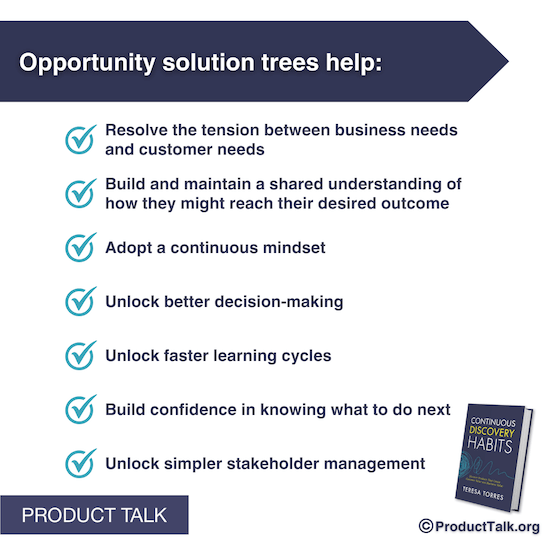
Opportunity solution trees help product trios:
- Resolve the tension between business needs and customer needs
- Build and maintain a shared understanding of how they might reach their desired outcome
- Adopt a continuous mindset
- Unlock better decision-making
- Unlock faster learning cycles
- Build confidence in knowing what to do next
- Unlock simpler stakeholder management
If you want to learn more about each of these benefits, check out:
Who should create an opportunity solution tree?
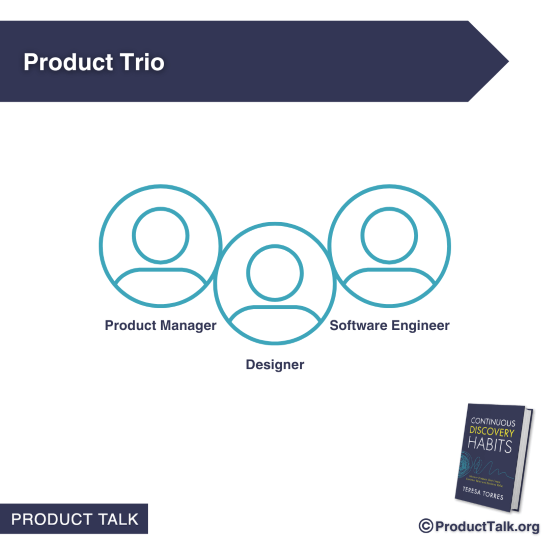
Opportunity solution trees are designed to help a product trio chart the best path to their desired outcome. It’s designed to be a team activity.
One of the key benefits of using an opportunity solution tree is it helps your team externalize and visualize your thinking, so it’s easier to align around what to do when.
But anyone can create an opportunity solution tree. So if you are looking to get some practice, go ahead and get started on your own. As you get comfortable with the tool, be sure to share it with your team. Sharing this article is a great way to introduce them to the concept.
Are there any prerequisites to using an opportunity solution tree?

Yes. Opportunity solution trees have several prerequisites:
- You should have a theory of your target customer and the value proposition you plan to offer them.
- You’ll need a clearly defined outcome. If you need help defining an outcome, start with our in-depth guide: Shifting from Outputs to Outcomes: Why It Matters and How to Get Started
- You’ll need to conduct three to four story-based customer interviews before starting your first opportunity solution tree. Explore our interview guide: Customer Interviews: How to Recruit, What to Ask, and How to Synthesize What You Learn
Don’t skip these prerequisites. Opportunity solution trees are nearly impossible to create when you don’t have good inputs.
Watch the short video below to learn why you should not make up opportunities.
How do you create an opportunity solution tree?

Follow these steps to create an opportunity solution tree:
- Make sure that you meet the prerequisites.
- Put your outcome at the top of the tree.
- Map the opportunity space. This is a messy process of synthesis. See the question below on how to structure the opportunity space.
- Choose a target opportunity.
- Brainstorm solutions for your target opportunity. Don’t brainstorm solutions across your entire tree. The goal is to focus on your target opportunity.
- Choose three solutions to explore further.
- Break your solutions down into their underlying assumptions and prioritize which assumptions to test first.
- Test the riskiest assumptions from each of your three ideas.
- As you collect data from your assumption tests, evaluate your solutions, and decide what to do next. You might:
- Throw some ideas away and generate new ones.
- Decide one of your ideas is good enough and continue to refine it for delivery.
- Decide you can’t deliver on the opportunity and choose a new target opportunity.
If you want to get a comprehensive overview of how to use opportunity solution trees, check out our Product Discovery Fundamentals course:
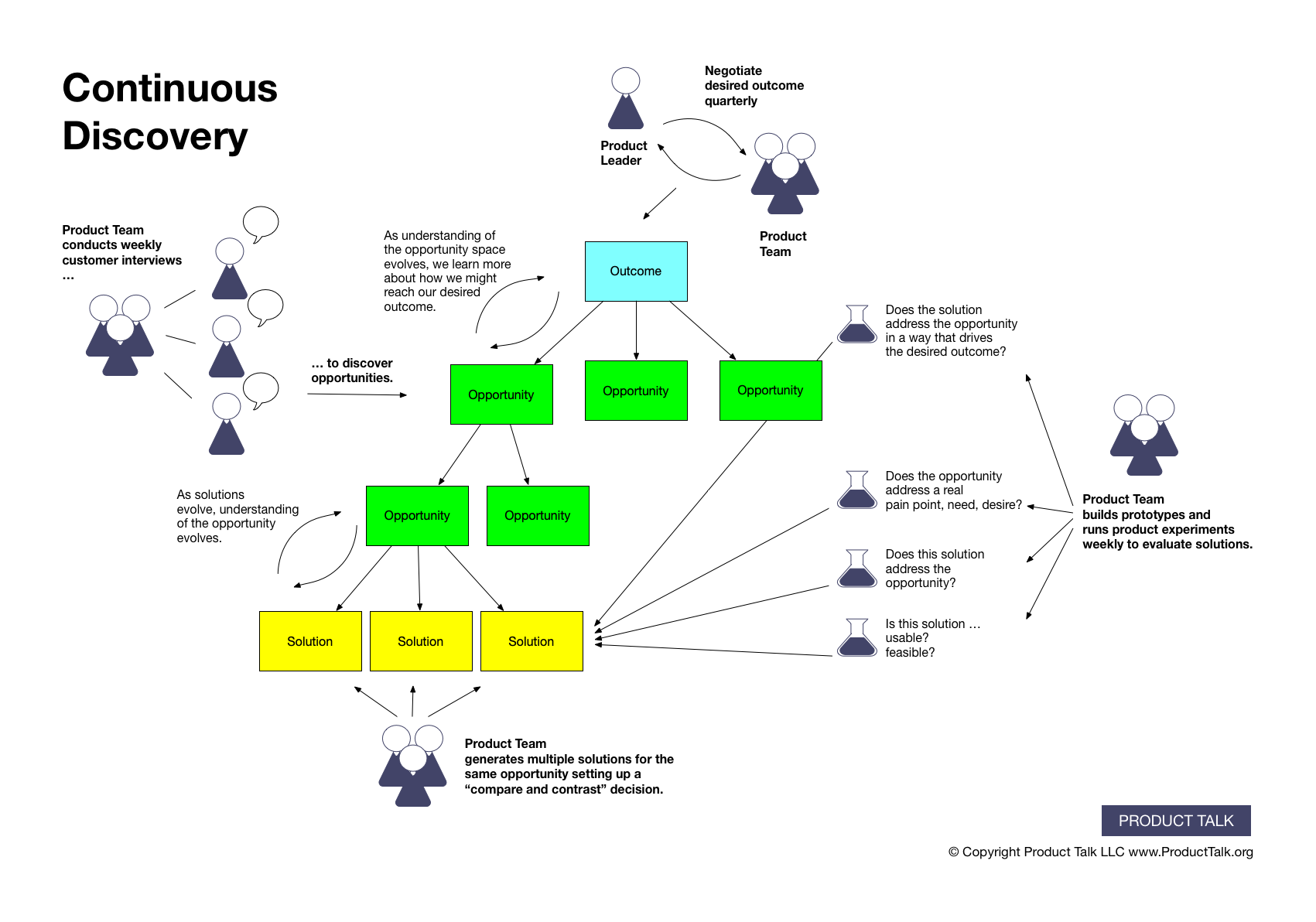
Understanding the Outcome at the Top of an Opportunity Solution Tree
The outcome at the top of an opportunity solution tree sets the scope for discovery. It helps teams understand which opportunities are relevant and keeps them focused on the right types of solutions.
What type of outcome should be at the top of an opportunity solution tree?

In my book Continuous Discovery Habits, I distinguished between three types of outcomes:
- Business outcomes measure the health of the business and are typically financial metrics like grow revenue, increase market share, or reduce churn.
- Product outcomes typically measure a customer behavior in the product or a customer sentiment about the product.
- Traction metrics measure adoption of a single feature.
This taxonomy helps us find the sweet spot for discovery. When we assign a team a business outcome, they don’t always know how to impact this metric, whereas product outcomes are directly within their control.
While traction metrics are important to measure, they aren’t good discovery outcomes because their scope is often too narrow.
As a general rule, I like to see a product outcome at the top of an opportunity solution tree.
For more, see: Shifting from Outputs to Outcomes: Why It Matters and How to Get Started
Why does the outcome focus on business value and not customer value?
One of the primary benefits of an opportunity solution tree is it helps us resolve the tension between customer value and business value. Too many companies create business value at the cost of customers.
The opposite problem is also pervasive. We have countless examples of companies that created lovable products, but those products didn’t create enough value for the business and they were ultimately shut down. Customer value does not always generate business value.
Just ask Google Reader customers. Google Reader was a beloved and heavily used product that was ultimately shut down by Google because it didn’t create enough value for Google. Dark Sky is a more recent example—this weather-tracking app was bought and shuttered by Apple.
An opportunity solution tree starts with business value (represented by the outcome) because when we create business value, we earn the right to serve our customer over time. The opportunity space ensures that we reach our outcome in a customer-centric way. This is how an opportunity solution tree aligns business value with customer value.
Opportunity solution trees help us discover products that are both desirable now and viable over time.
What if you are being asked to deliver more than one outcome?
In an ideal world, an empowered product team is working on one outcome at a time. This allows teams to focus and have an outsized impact on their outcome. However, most of us don’t live in the ideal world.
If you are being asked to deliver multiple outcomes, I recommend you prioritize your outcomes yourself, and create an opportunity solution tree for your most important outcome. It’s not possible to develop a rich understanding of an opportunity space for multiple outcomes at the same time.
What if multiple teams are being asked to deliver the same outcome?
Teams will feel more accountable, move faster, and thus have more impact, if they each focus on their own outcome. If you have multiple teams working on the same outcome, split the outcome so that each team has their own outcome.
There are a couple of ways to split outcomes:
- You can split the outcome by customer segment. For example, if you have multiple teams focused on engagement, you can split the outcome by having each team focused on different customers based on their tenure. For example, one team could focus on first-time users, whereas another team could focus on customers who are 3–12 months into using the product, and so on.
- You can split the outcome by customer journey step. For example, you could have one team focused on onboarding, another team focused on activation, and another team focused on retention.
As a general rule, set one unique outcome for each team.
Understanding the Opportunity Space
The opportunity space is where the magic happens. The better we understand our customers’ unmet needs, pain points, and desires, the easier it will be to develop successful solutions.
Companies differentiate themselves from competitors by building a richer understanding of the opportunity space.
What is an opportunity?
In this context, an opportunity is an unmet customer need, pain point, or desire.
Opportunities expose gaps in the market where we can immediately create value for our customers. When we address opportunities in a way that drives our outcome, we create both customer value and business value.
What’s the difference between an opportunity and a solution?

A solution is a product, a service, or a feature that we offer to address an opportunity. The opportunity represents the underlying need, pain point, or desire.
For example, the following are opportunities:
- I’m hungry.
- I don’t know what to eat for dinner.
- I don’t have time to cook dinner.
And the following are solutions:
- Order takeout.
- Go out to eat at a local restaurant.
- Subscribe to a meal prep service.
How do you test to make sure your opportunity is not a solution in disguise?
If you are new to identifying opportunities, it can be easy to confuse opportunities and solutions. The best way to test if an opportunity is really a solution in disguise is to ask, “Is there more than one way to address this opportunity?”
For example, if we start with a statement like, “I want to go out to eat,” this sounds like an opportunity, but it’s really a solution. The only way to address it is to go out to eat.
We can reframe this opportunity by asking, “Why do you want to go out to eat?” We might uncover a number of opportunities:
- I don’t have time to cook.
- I want to eat right now.
- I want something that tastes better than what I know how to make.
Each of these opportunities has a variety of solutions. “I want to go out to eat” is just one of many solutions.
Why is it called an opportunity and not a problem?
In the product world, we don't just solve customer problems. The word "problem" implies something needs fixing. However, we have many examples of products or services that don't fix problems.
Disneyland entertains me; ice cream is delicious; mountain biking is fun. These products address my desires. I could try to shoehorn these desires into needs—I need something to fill my time, I need nutrients, and I need to exercise. However, writing a book, eating spinach, and going to the gym might be more effective ways of addressing these needs.
The key difference here is that I enjoy Disneyland, ice cream, and mountain biking. These products were designed to address my desires, not solve my problems. Opportunities include needs, pain points, and desires.
How do you find opportunities?
In my book Continuous Discovery Habits and in our Story-Based Customer Interviews course, we teach story-based interviewing. This is a form of interviewing that involves collecting specific stories about past real-world behavior.
A story-based interview might start with a prompt of the form, “Tell me about a time when…” For example:
- Tell me about the last time you watched streaming entertainment.
- Tell me about the last time you checked your email.
- Tell me about your last meal.
Opportunities emerge from these stories. Stories naturally expose unmet needs, pain points, and desires. When we learn about opportunities in the context of a story, we develop a rich understanding of the underlying need. We understand when the opportunity occurred, what the customer was trying to do, and much more.
Learn more about story-based customer interviews:
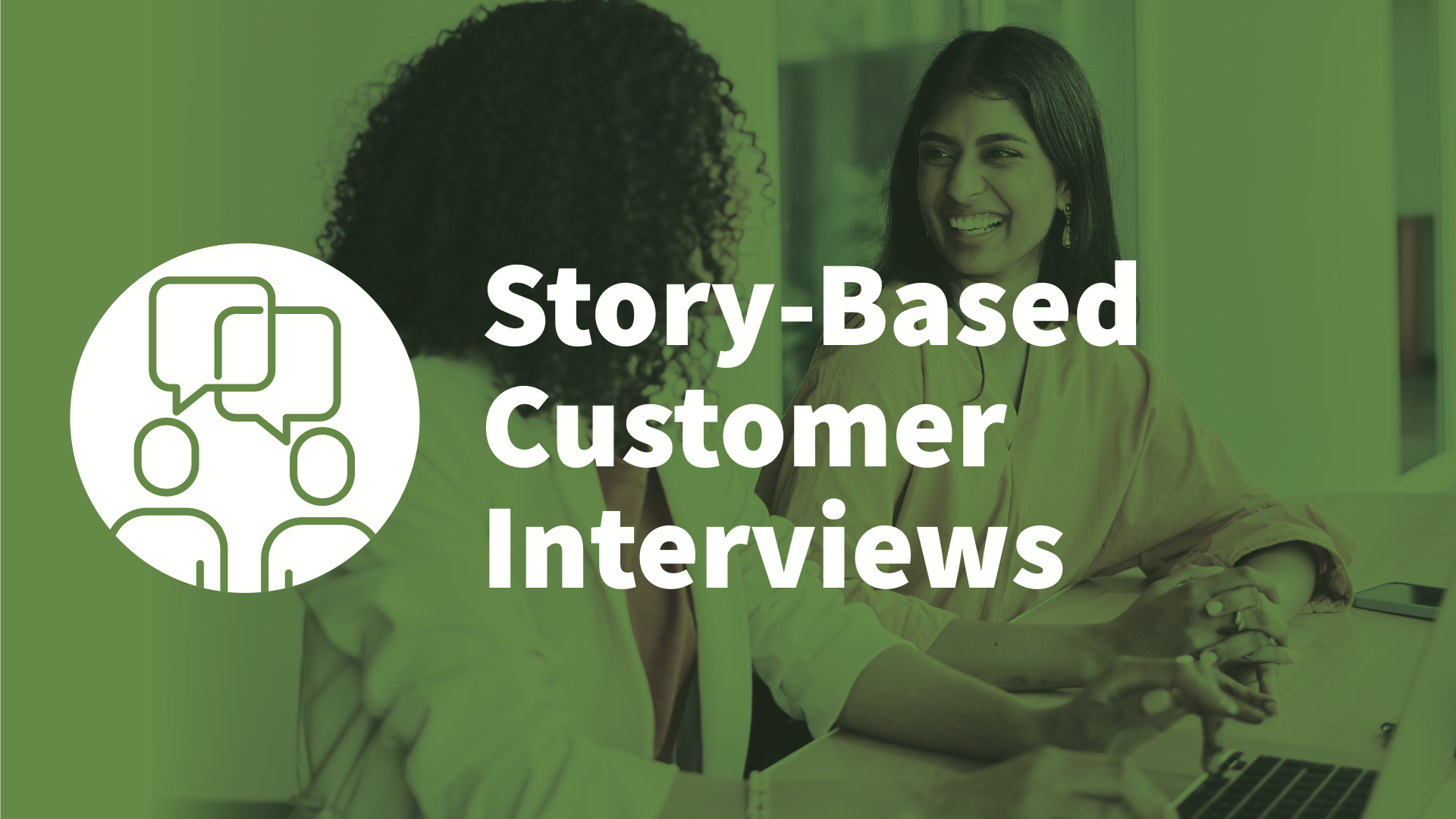
Why can’t you just generate opportunities from what you know about your customers?
When we generate opportunities off the top of our heads, we bring our own biases and half-truths into the picture. We don’t want to waste time addressing opportunities that aren’t real. When we limit the opportunities on the opportunity solution tree to just the opportunities we hear in customer interviews, we guarantee that we are working on real unmet customers needs, pain points, and desires.
Can you create opportunities from sales conversations, support tickets, feature requests, or behavioral analytics?
Naturally, opportunities might emerge from other sources like sales conversations, through support tickets, and from other customer-facing teams. However, most of the time when we hear about an opportunity through these sources, it is missing context. We don’t have enough information to fully understand the opportunity. This puts us at risk of addressing the wrong opportunity. I like to use these sources as inspiration for what to explore in my upcoming interviews. See this article for more on this topic: Ask Teresa: What Should You Do With Insights That Don’t Come from Customer Interviews?
Mapping the Opportunity Space
It’s common for product teams to overreact to the most recent customer interview, sales conversation, or support ticket. This reaction comes from good intent. We want to help our customers.
The challenge, however, is we forget to ask, “Is this the most important area for us to focus on right now?”
When we take the time to map the opportunity space on an opportunity solution tree, we get a big-picture view of how we might reach our outcome. We are better able to compare and contrast the value of addressing different opportunities against each other. We are able to make more strategic decisions.
When are you ready to start mapping out the opportunity space?
I encourage teams to start mapping the opportunity space after collecting three to four customer stories. This is enough to prevent you from overreacting to a single story, but not so many that you get overwhelmed and fall into analysis paralysis.
But this doesn’t mean you do three to four customer interviews and then you are done. You want to interview customers continuously—week over week. For every three to four interviews that you conduct, you want to revise and refine the opportunity space on your opportunity solution tree.
How do you structure the opportunity space?

Structuring the opportunity space is a messy synthesis process and takes time. But you can break it down into four simple steps:
- Create an experience map that represents all of the stories you collected in your interviews.
- Map the moments in the experience map to your top-level opportunities.
- Group each of the individual opportunities from your customers’ stories under the top-level moment in which it occurred.
- Structure each branch one at a time creating parent-child and sibling relationships.
How do you manage the messiness of the opportunity space over time?
When you are creating an opportunity space for the first time, it’s normal for it to sprawl and be messy. That’s because you are still learning about the underlying structure of the opportunity space. It’s an iterative process that takes time to sort out.
But as you conduct more interviews and continue to refine the opportunity space, the structure should stabilize. The key moments at the top of the tree shouldn’t change too often. Instead, the refinements should come from exploring each branch and adding more detail as you work your way down the tree.
If your opportunity solution tree continues to be a mess after six to eight interviews, I recommend checking out our Opportunity Mapping course.
How do you represent customer segments on an opportunity solution tree?
Sometimes it makes sense to add customer segments to the top of your opportunity solution tree. This can be helpful when one team is responsible for meeting the needs of both sides of a marketplace (e.g. meeting the needs of both employers and job seekers on a job board). It can also be helpful when working on products that are used in complex ecosystems (e.g. electronic medical records that might be used by physicians, nurses, and office administrators).
However, your opportunity solution tree should match the scope of your team’s remit. If your team is responsible for meeting the needs of multiple audiences, you might have customer segments at the top of your tree. If your team, on the other hand, is simply focused on one of these audiences, then you don’t need to put customer segments on your tree.
If you want to learn more about how to represent customer segments on an opportunity solution tree, check out these articles:
- Representing Customer Segments on Your Opportunity Solution Tree (Hope’s Take)
- Representing Customer Segments on Your Opportunity Solution Tree (Teresa’s Take)
Choosing a Target Opportunity
I encourage product teams to work on one small opportunity at a time. This is consistent with the principle of limiting work in progress that comes from kanban. It helps us deliver value iteratively. And most importantly, it’s what allows us to explore multiple solutions, setting up good compare and contrast decisions.
When are you ready to choose a target opportunity?
Choose a target opportunity as soon as you have a first draft of the opportunity space. This is where I want to see teams push the pace. Don’t spend hours on your first opportunity space. Embrace a “crummy first draft” mindset. Get a rough sketch of the opportunity space and then choose a target opportunity.
You might not feel ready to do this, but you are. Your opportunity space will continue to evolve as you interview more. But you want to start exploring solutions and testing assumptions as soon as possible. This is where most of the learning in discovery happens. So push to get there as soon as you can.
How do you assess and prioritize opportunities?

In my book Continuous Discovery Habits, I outlined four sets of factors that I like to assess when evaluating opportunities.
- Opportunity sizing: How many customers are affected and how often?
- Market factors: How would addressing each opportunity affect your product’s position in the marketplace?
- Company factors: How does each opportunity support your company mission, vision, and strategic objectives?
- Customer factors: How important is each opportunity to your customers and how satisfied are they with existing solutions?
You can learn more about this framework in Chapter 6 of Continuous Discovery Habits.
Why don’t you include effort when assessing opportunities?
Solutions take effort. But we aren’t exploring solutions yet. Any given opportunity can have both easy and difficult solutions. We evaluate effort when we explore solutions and through feasibility assumption testing.
I’ve seen many teams assume that an opportunity will be too hard to address, and then once they choose it, they uncover a dead-simple solution. Don’t rule out an opportunity too early.
Understanding Solutions
Product teams create value by shipping and iterating on existing solutions.
What’s a solution?
A solution can be a product, a feature, a service, a workflow, a process, documentation, or anything else that we offer to customers to help address a known opportunity.
Can a solution solve more than one opportunity at once?
Many product teams are used to designing project-sized solutions that take weeks, months, or years to deliver. These solutions tend to address multiple opportunities at once.
However, as teams shift to a more continuous cadence, solutions tend to get smaller and smaller. This is what allows us to deliver value continuously. Many teams ship every day and some even ship value to customers several times a day.
Matching a small solution to a single opportunity is a good way to unlock a continuous cadence.
Why should you consider multiple solutions for the same target opportunity?

Decision-making research tells us when we compare and contrast our options, we make better decisions. As a general rule, I recommend that teams consider more than one solution for their target opportunity.
In reality, we don’t always have time to do this. Compare and contrast when there’s risk in the solution, when the opportunity is a differentiator, or you need to uncover an innovative solution.
How do you decide which solutions to pursue?
The best way to evaluate solutions is through assumption testing. When we test the assumptions that our ideas depend upon, we collect the compare and contrast data we need to make a better decision.
You can learn more about assumption testing here.
How do you know when you are ready to build a solution?
This depends on several factors:
- How much risk does the solution have?
- How much risk can our organization bear?
- How much time do we have to make a decision?
There are no black and white answers in discovery. Whenever we put a solution in our delivery backlog, we are making a bet. Discovery helps us reduce the risk of that bet. How much risk we need to mitigate will depend on the answers to these three questions. If there’s more risk than our organization can bear or if we have more time, we might choose to do more discovery. If we are running out of time or don’t see a lot of risk in a solution, we can do less discovery.
The challenge is when we are new to discovery, we aren’t very good at assessing risk. To mitigate this risk, when new to discovery, do a little more discovery than you think you need.
Tools & Templates
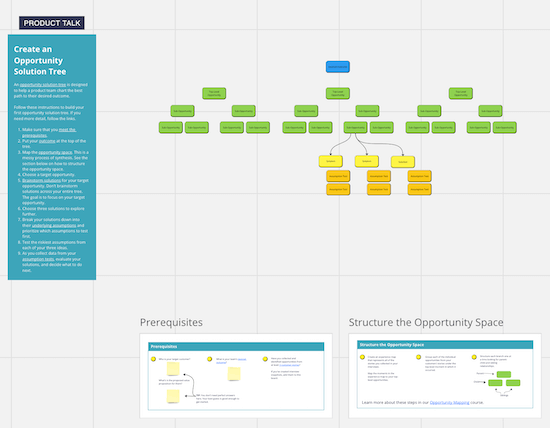
Opportunity solution trees have grown in popularity since their inception in 2016. As a result, we have many tools and templates we can use to create opportunity solution trees.
What tool should you use to create an opportunity solution tree?
You can create an opportunity solution tree in any visual tool that allows you to create shapes and arrows. I recommend that teams start with a tool that they are already familiar with.
I, personally, like to keep things simple. I use Miro for all of my opportunity solution trees. But other digital whiteboards like Mural or Jamboard also work.
I used to create my trees in OmniGraffle. And any flowchart software will also work. I know many teams use Lucidchart to create their trees.
There are some tools being built specifically for opportunity solution trees. Vistaly is a startup in this space that has happy customers.
We featured a few of these tools in a recent Tools of the Trade article.
Where can you get an opportunity solution tree template?
I’ve created opportunity solution tree templates for the following tools. I’ll add links to more as we create them.
Managing Scope and Iterations
Creating an opportunity solution tree is not a one-time activity. An opportunity solution tree is a living document that should evolve as you learn from your discovery activities.
When should you start a new opportunity solution tree?
An opportunity solution tree is designed to help you chart the best path to your desired outcome. You should start a new tree whenever you start working on a new outcome.
Outcomes typically have a directional component and a goal. For example, suppose our outcome is to increase the percentage of first-time users who get to our aha moment during their first session from 22 to 25%. “Increasing the first-time users who get to the aha moment during the first session” is the directional component and “25%” is the target.
We only need to create a new tree when the directional component changes. We don’t need to start a new tree when the target changes.
Suppose we hit 25% and we set a new goal to get to 30%. We can keep working from the same tree.
However, we might start a new tree if any of the following happens:
- We decide to focus on acquiring more customers (the directional outcome changes completely)
- We decide to change our aha moment (the directional outcome changes meaningfully)
How often should you update your opportunity solution tree?
I recommend you revisit the opportunity space every three to four customer interviews. If you are interviewing at least weekly, this is roughly every three to four weeks. If you are interviewing more often, you’ll want to update it more often.
Three to four interviews is a good amount of new data to work with so that you don’t over index on a single interview, but it’s not so much new data that you’ll feel overwhelmed.
What’s the best way to introduce the opportunity solution tree to your team?
First, make sure you meet the prerequisites. Seriously, don’t overlook these. I see way too many teams making up opportunities from scratch. This misses the point of opportunity solution trees. The goal of an opportunity solution tree is to help you make sense of what you are learning from your discovery activities. Start with interviewing and assumption testing.
Once your team meets the prerequisites, share this article with them.
What’s the best way to run an opportunity solution tree workshop?
I know I’m starting to sound like a broken record. But please start with the prerequisites.
Once you meet the prerequisites, you can follow these steps to create your first tree.
You can use these templates to walk your team through it:
We've also shared stories about how other teams have run opportunity solution tree workshops:
- Lily Smith ran an opportunity solution tree workshop at BBC Maestro
- Tali Melchior ran an opportunity solution tree workshop at TextHelp
Can you create one opportunity solution tree for the entire company?
I don’t recommend this. I’ve seen many companies try and it never turns out well.
Remember, the purpose of an opportunity solution tree is to help one product trio chart the best path to their desired outcome. When you expand the scope beyond this, it tends to get too unwieldy.
I suspect companies try to create a company-wide opportunity solution tree when they are trying to get a company-wide view of their strategy or vision. To support these activities, I recommend creating a KPI tree and/or a company-wide experience map.
Managing Expectations with Stakeholders
It’s not enough to do good discovery work, we also need to communicate what we are learning to our stakeholders, so that they can come along on the learning journey with us. When we bring stakeholders along, it’s easier to justify our decisions and get their buy-in.
What’s the best way to share your opportunity solution tree with stakeholders?
In the same way that opportunity solution trees help us stay aligned as a team as we work through our discovery cycles, they can also help us communicate what we are learning to our stakeholders.
When sharing your opportunity solution tree, start by answering these two questions:
- Who needs to be kept up to date on our progress?
- For each person that needs to be kept up to date, ask, “What’s the right level of detail to share with them?”
Some stakeholders that are close to the work might want to hear about every interview and assumption test. For these stakeholders, I would share the entire opportunity solution tree.
Other stakeholders might just want the highlights. For these stakeholders, I might just share my top-level opportunities, and some specifics around our target opportunity.
The key is to match the right level of detail to the right stakeholder.
To see a real-world example, check out: Engaging Stakeholders with Opportunity Solution Trees: 3 Tactics to Try
How does an opportunity solution tree connect to a product roadmap?
It depends on the type of roadmap and the role roadmaps play in your organization.
If you use a traditional date-based roadmap where you list features with release dates, then your roadmap represents the solutions that have already been matched to opportunities on your solution tree and vetted by assumption tests.
If you use an outcome-oriented roadmap (like a Now Next Future roadmap), then your roadmap might include opportunities and solutions from your opportunity solution tree. It might also include outcomes you plan to explore next.
How does an opportunity solution tree connect with a product vision?
A product vision typically describes the impact you want your product to have on the world. It rarely gets into how you’ll get there. Your vision might include a high-level outcome, but it probably doesn’t get to the level of specificity of each team’s outcomes. Nor does it include the specific opportunities or solutions that might address those outcomes.
Product visions tell us where we are headed. Opportunity solution trees help us get there.
Examples of Opportunity Solution Trees
The best way to learn about opportunity solution trees is to build your own, but it can also be helpful to see specific examples of how other teams build their trees. You can find some of the examples we've collected over the years here.
What are some examples of opportunity solution trees?
We have shared several real-world examples of opportunity solution trees:
- Engaging Stakeholders with Opportunity Solution Trees: 3 Tactics to Try
- Product in Practice: Getting Started with Opportunity Solution Trees at SuperAwesome
- Product in Practice: When Travel Ground to a Halt, Seera Group Used Opportunity Mapping to Discover a New Market
- Bringing Order to Chaos: Using Opportunity Solution Trees in Everyday Life
- Product in Practice: Opportunity Mapping Led to a 20% Lift in LTV at Grailed
- Product in Practice: Mapping Opportunities at trivago
What other questions do you have about opportunity solution trees?
Now we want to hear from you. Is there anything we missed? What other questions do you have about opportunity solution trees?






Comments ()